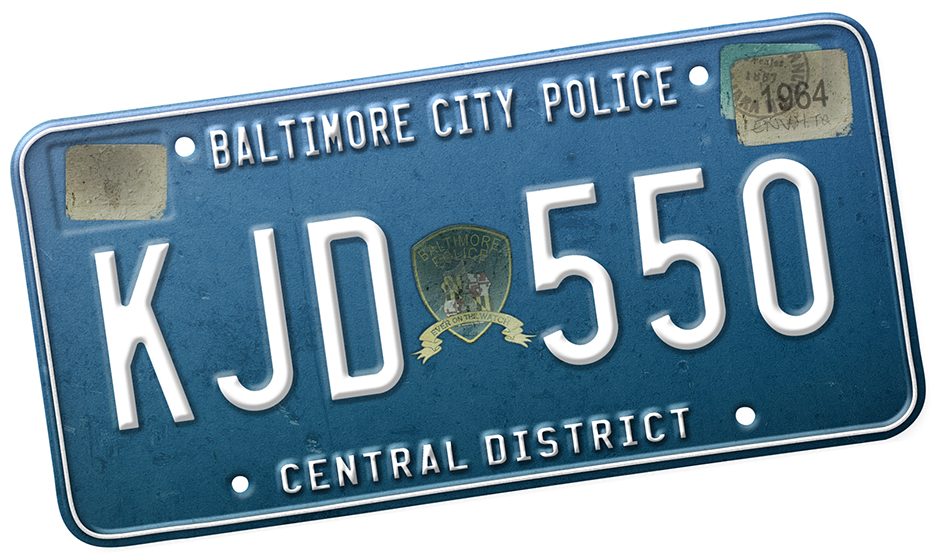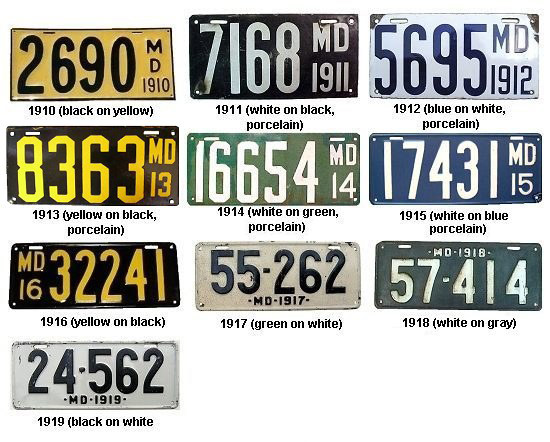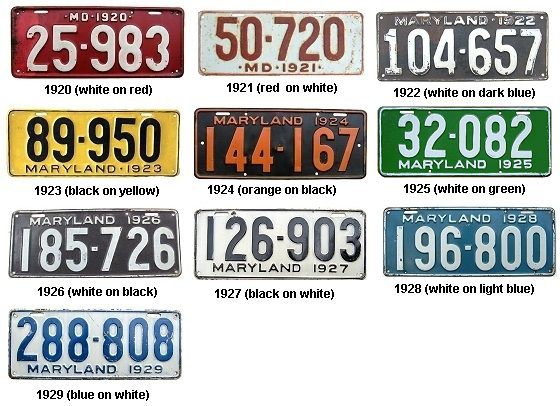 MARYLAND AUTO TAGS IN HISTORICAL REVIEW
MARYLAND AUTO TAGS IN HISTORICAL REVIEW
22 April 1934
Newspapers of the Times; Apr 22, 1934; pg. TM1
State now makes its own license plates at the penitentiary – Wars with the District and Pennsylvania are recalled
The first history of makers of any kind of automobiles in Maryland date from 1904, when one dollar was required to be paid by the owner of the motor car to the secretary of state, 644 applications were issued that year in Annapolis, the first being 128, done in May 1904. To Earl MacNeill Shannahan, of Easton, Talbot County. The records do not show the make of his motor vehicle, but it was registered as having 8 hp. The number of vehicle's license had to be painted somewhere on the vehicle, preferably on the side glass of the two carriage lamps with which it was usually equipped.
The more “doggie” of the ball corn honkers of Baltimore, however, and those Automobilist at the other end of the extreme, were those who had no lights. At the time lights were not mandatory and were only needed by the more daring and adventurous; "Those who drove at night!" In addition, one of the sporting good shops of those days, was selling a black patent leather flap with the allotted license number on it in large aluminum figures similar to those used to number our houses today.
With this plate attached to the rear axle of the chariot, the complaint was registered by the auto owners that the tag was too big and conspicuous. The new Commissioner's reply to this protest was a more visible proof of his privilege to rush around on the county roads at the maximum legal lightning speed of 1 mile in six minutes, or 10 miles an hour, provided he could make it, the motorist was perfectly content. Little did he realize that trouble in the way of license plate was coming his way in the years to come.
Other troubles were there to perturb him even more at the time. For one, he was allowed only 6 miles an hour in Druid Hill Park and was apt to be chased and caught by any bicyclist who thought he was exceeding that rate; (this was before radar) and the cars of the time were not equiped with speedometers on either the vehicles or the peddling and probably perspiring policeman’s gas at the speed was the last word and the law, and the law said the fine was $12. In many of the parks of other cities during the same era, notably in Central Park, New York City, he would not be allowed at all, but as his automobile required the aid of a freight car to reach such distant proportions of the country, most Maryland motorist only knew of this band by hearsay and so derives a little consultation there from.
In 1908, one governor Crothers advocated the creation of The Office of an Automobile Commissioner, he admitted that, while the fees so collected would probably not be sufficient to pay the salary of such an official for the first year, possibly even as much as $100,000 might be raised by it annually in the future
 CONSERVATIVE PROFIT
CONSERVATIVE PROFIT
$100,000 was termed a Conservative Profit, it should be mentioned that a little over 9 1/2 million was the total revenue derived from automobiles in Maryland in 1933. But for the Governor to call $100,000 a Conservative Profit just shows these folk in office have never had any sense or reality.
Official metal license plates for automobiles in Maryland date, therefore back to 1910, or about two years after the appointment of John E. George, The first Commissioner of Motor Vehicles.
In addition, Maryland Automobilists were required to have District of Columbia plates and an operator's license card for Washington in order to enter that city. Finally, through the organized efforts of the Automobile Club of Maryland, which was founded around 1901, full reciprocity between Maryland and the District, eliminating this necessity, was established, but this was not achieved until 1924.
 MADE FIRST PLATES
MADE FIRST PLATES
An automobile war existed for a short time between Maryland and Delaware, when it was obligatory for the Maryland car to have attached the plates of Delaware in order to cross the state lines.
The first Maryland plates were made by a metal ceiling company in New York – a few years later they were made in Kentucky. In 1918, just at the close of the 1st world war, production of all the tags were restricted and delayed, that it was not until 12 o'clock midnight of December 31 that those for solid tired vehicles arrived. Soldiers were rushed from one of the neighboring military camps and they assisted in unloading the freight car containing the new plates, getting the tags to the office of distribution just in time to issue them on the very morning that they were required.
It was in 1918, that the only color dye obtainable was so poor for the black background used that year, that, like the foliage of the trees, it turned green in the spring and to a sticky gray and winter. Indian dyes have been adopted since and the colors now more permanent.
.jpg) STAMPER A "LIFER"
STAMPER A "LIFER"
In 1923, which was a couple of years after Col. Claude E. Sweezy assumed charge of the penitentiary, the manufacture of auto license plate had begun in the penitentiary and they were made by convict labor for many years after that. The shop in which this was done was located at one end of a large courtyard of the penitentiary and occupies two floors, the first floor developed into the cutting of metal sheets into the proper size, punching holes, stamping the numbers and trimming; the second floor did the enameling work in the auto license shop of the penitentiary.
The men manipulate the Die Stamps were "lifers" other shorter term inmates attended to the two dippings of the background colors, done by means of slowly traveling, hanging racks, and to the operation of the linked walls by means of which the raised portion of the plate are colored. Fire engine tags were red and police car tags were blue. Both fire and police tags were done by hand but run mechanically through the same baking ovens as the other tags would have been run through.
Maryland was one of the pioneer states to put its prisoners to work making auto license plates. Initially Maryland also made the tags for other states, but later many of the Commonwealth states introduced this work into their own penal systems.
.jpg) COMPLETE SET RARE
COMPLETE SET RARE
A complete set of all the tags of any state is extremely rare, and, in consequence, of considerable value to collectors of such things. One set for Maryland happened to be owned by a chauffeur in the family of the present 1934 Commissioner of Motor Vehicles, who years after year had nailed them up in the family garage after they became outdated. It was from these originals that the early specimens were reproduced in the penitentiary for the full set of Maryland tag plates which in 1934 could have been found hanging on the walls of the Automobile Commissioner's building at Guilford Avenue and 22nd St.
Special blocks of numbers and tags were assigned to electric autos, of which there are comparatively few, to commercial vehicles for hire to motor trucks, motorcycles, sidecars and trailers, solid tired vehicles, used cars, buses and dealers. Latest of all are tags to employers, giving them the right to haul few – workmen for pay to and from their office or shop.
Private car numbers in the city of Baltimore begin nominally with 30,000, but the first 2000 of these that is all those beginning with 30,000 itself and 31,000 are what is known as gratis tags and were reserved for official use. The actual city numbers, therefore, private cars begin with 32,001 and in 1934 there were as many as 149,000.
From 150,000 to 199,000 was for commercial trucks. From 200,000 and up were allotted to the privately owned cars of the counties.
Maryland Colors
The following are the colors that Maryland has used for its auto plates since metal tags were first introduced:
1910 – Black on Gold
1911 – White on Black
1912 – Blue on White
1913 – Canary on Black
1914 – White on Green
1915 – White on Blue
1916 – Yellow on Black
1917 – Blue on White
1918 – White on Black
1919 – Black on White
1920 – White on Red
1921 –White ?
1922 – White on Blue
1923 – Black on Yellow
1924 – Maroon on Black
1925 – White on Green
1926 – White on Dark Blue
1927 – Blue on White
1928 – White on Blue
1929 – Blue on White
1930 – White on Green
1931 – White on Red
1932 – Red on White
1933 – White on Blue
1934 – Black ?
The tags for 1935 – In were blue on white, when the state colors were substituted on account of the Tercentenary celebration. The slightly thinner grade of steel was also used for 1934 – 22gauge instead of the customary 20gauge – on account of the additional lead lettering necessary to be pressed into it.
A dozen or more grades and shades of enamel of white on black, which was the color combination for 1936, are being tested out now on plates exposed up on the roof of the penitentiary shop, where they are still to remain for months. Those pigments best withstand this test will be the one selected.
ALTERNATION
Beginning with 1917, the numerals of the year and the MD. For Maryland, which since 1922 has been written out in full to avoid confusion with the MO. Abbreviation for Missouri, have alternated top and bottom on our license plates.
In ODD YEARS, the name of the state appears above the license numerals and
In EVEN YEARS below them. 1934 however, violated that rule in order to embody the word Tercentenary.
Tags returned to the automobile Commissioner's office for a refund, or for any other reason, were cut up and thrown in the city’s dump. But several years ago and enterprising though not over scrupulous Automobilist, laboriously riveted some of the small pieces he found thus thrown away into a pair of matching plates and drove for some time under these matched up, false colors, until hauled into the traffic court for some other offense, when his money-saving scheme was discovered.
Since which time discarded auto tags have been turned over to a local sash-weight company – where they are melted down and put to raising windows instead of taxes

Maryland License Plates
Maryland registered 9,000 vehicles from 1904 to 1910 when the state first started to issue license plates. In 1910, Maryland license plates were manufactured in a thin metal which was crudely embossed by hammering over wooden dies. From 1911 through 1914, license plates of Maryland were made of porcelain. Steel replaced porcelain in 1915. The first slogan to appear on Maryland’s license plates was TERCENTENARY to celebrate three hundred years of statehood in 1934. The state name Maryland or MD and the year was always embossed on license plates. The slogan DRIVE CAREFULLY appeared on all Maryland license plates starting in 1942 and ended in 1947.
Maryland embossed an expiration date on its license plates beginning in 1936 through 1947 and the expiration date was always: 3-31-year (2 digits of year). The expiration date reappeared in 1957 and ended in 1970 (03-31-70).
Maryland did not introduce retro-reflective 3M foil over an aluminum substrate until 1986 and this continues today to meet the US Department of Transportation (DOT) mandates. The first license plate with graphics was issued in 1976 to commemorate the nations Bi-centennial celebrations. Maryland’s first wide scale license plate with graphics was issued in 1993 and this issue is valid today.
In 1910, Maryland had no reciprocity laws with other states and because of its closeness to Washington, D.C. and Virginia, many vehicles were seen with three license plates (Maryland, Washington, D.C. and Virginia). Maryland agreed in 1923 to enact reciprocity laws with these states. Maryland’s license plates were made by the state’s prison system, expect for 2005, due to violence. The state of New Jersey prison system manufactured Maryland’s license plates.
Maryland has a large car collector population and many “old car shows” where collectors gather and show off their classic vehicles from January to December. Collectors have used our replica metal license plates for showing their vehicles and have won many Best in Class or Best of Show trophies.
You can have custom plate made HERE

POLICE INFORMATION
Copies of: Your Baltimore Police Department Class Photo, Pictures of our Officers, Vehicles, Equipment, Newspaper Articles relating to our department and or officers, Old Departmental Newsletters, Lookouts, Wanted Posters, and or Brochures. Information on Deceased Officers and anything that may help Preserve the History and Proud Traditions of this agency. Please contact Retired Detective Kenny Driscoll.
This email address is being protected from spambots. You need JavaScript enabled to view it.

NOTICE
How to Dispose of Old Police Items
Please contact Det. Ret. Kenny Driscoll if you have any pictures of you or your family members and wish them remembered here on this tribute site to Honor the fine men and women who have served with Honor and Distinction at the Baltimore Police Department.
Anyone with information, photographs, memorabilia, or other "Baltimore City Police" items can contact Ret. Det. Kenny Driscoll at This email address is being protected from spambots. You need JavaScript enabled to view it. follow us on Twitter @BaltoPoliceHist or like us on Facebook or mail pics to 8138 Dundalk Ave. Baltimore Md. 21222
Copyright © 2002 Baltimore City Police History - Ret Det Kenny Driscoll





.jpg)
.jpg)
















